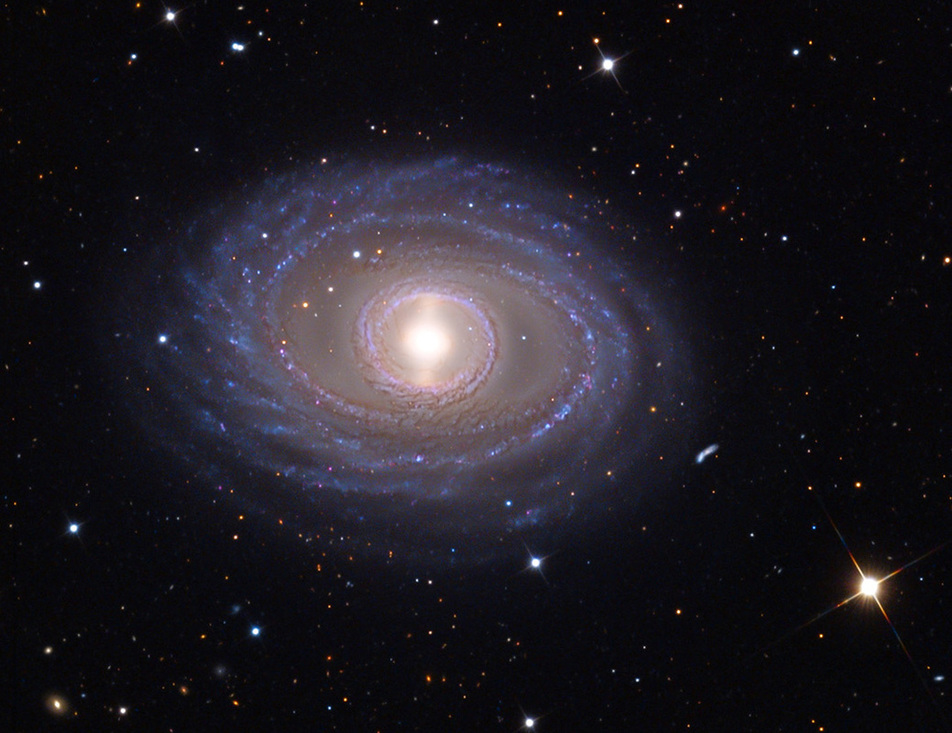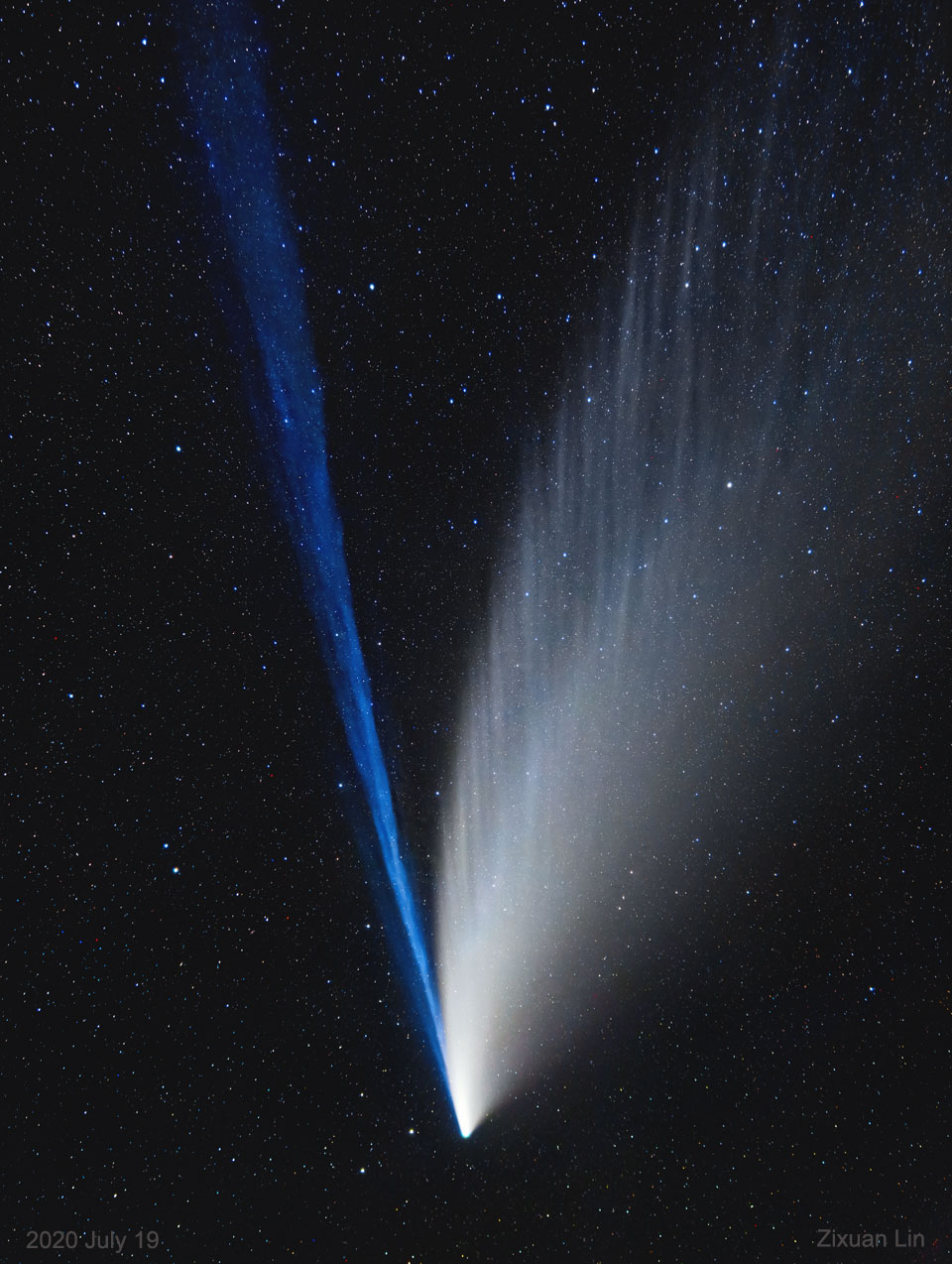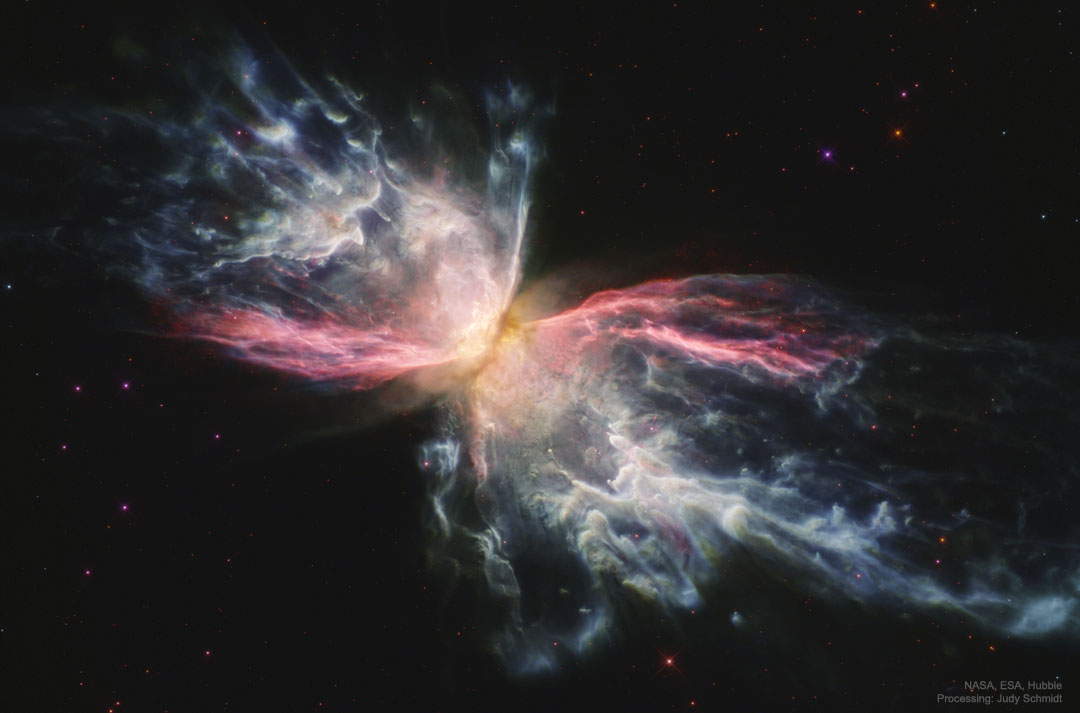Blog
Malagueñas derive from local variety of the Fandangos, a type of dance that, with different regional variations and even different names, became very popular in great part of Spain in the 18th century. Although nowadays malagueñas are a typical instance of “cante libre”, performed at libitum and normally not used for the dance, folkloric fandangos were originally sung and played at a fast speed, with a rhythmic pattern in 6
8, to accompany dance. Some of these primitive fandangos from Málaga, called Verdiales are still performed nowadays at folkloric gatherings by large non-professional groups called “Pandas”, which use a high number of guitars, “bandurrias” (a sort of mandoline), violins, and tambourines.
more...
https://www.youtube.com/watch?v=gFgHlDimqSw
more...NGC 1398 is an isolated barred spiral galaxy exhibiting a double ring structure. It is located 65 million light years from the Earth, in the constellation of Fornax. The galaxy, with a diameter of 135,000 light years, is slightly larger than the Milky Way. Over 100 billion stars are in the galaxy. It was first discovered by Friedrich Winnecke of Karlsruhe, Germany, on 17 December 1868, while he was searching for comets.

Lakshminarayana Subramaniam (born 23 July 1947) is an Indian violinist, composer and conductor, trained in the classical Carnatic music tradition and Western classical music, and renowned for his virtuoso playing techniques and compositions in orchestral fusion.
Subramaniam was born to V. Lakshminarayana Iyer and Seethalakshmi, both accomplished musicians.
He lived in Jaffna during his younger years, taking up music studies before the age of five. He began training in violin under the tutelage of his father, Professor V. Lakshminarayana. “Mani”, as he is fondly known by fellow musicians and his family, gave his first public performance at the age of six.
His uncles include Ramnad Raghavan and Ramnad Krishnan. His brothers are also acclaimed musicians, and include the violinist-composers L. Shankar (alias. Shenkar), and the late L. Vaidyanathan. He has released recordings with both.
Subramaniam developed a passion for music as well as science from a young age, studying Medicine and acquiring his M.B.B.S. at Madras Medical College. He registered as a General Practitioner, before deciding to pursue music full-time. He has a Master’s degree in Western classical music, which he acquired at the California Institute of the Arts.
more...Steve Lacy (July 23, 1934 – June 4, 2004), born Steven Norman Lackritz in New York City, was an American jazz saxophonist and composer recognized as one of the important players of soprano saxophone. Coming to prominence in the 1950s as a progressive dixieland musician, Lacy went on to a long and prolific career. He worked extensively in experimental jazz and to a lesser extent in free improvisation, but Lacy’s music was typically melodic and tightly-structured. Lacy also became a highly distinctive composer, with compositions often built out of little more than a single questioning phrase, repeated several times.
The music of Thelonious Monk became a permanent part of Lacy’s repertoire after a stint in the pianist’s band, with Monk’s songs appearing on virtually every Lacy album and concert program; Lacy often partnered with trombonist Roswell Rudd in exploring Monk’s work. Beyond Monk, Lacy performed the work of jazz composers such as Charles Mingus, Duke Ellington and Herbie Nichols; unlike many jazz musicians he rarely played standard popular or show tunes.
Lacy began his career at sixteen playing Dixieland music with much older musicians such as Henry “Red” Allen, Pee Wee Russell, George “Pops” Foster and Zutty Singleton and then with Kansas City jazz players like Buck Clayton, Dicky Wells, and Jimmy Rushing. He then became involved with the avant-garde, performing on Jazz Advance (1956), the debut album of Cecil Taylor,[2]:55 and appearing with Taylor’s groundbreaking quartet at the 1957 Newport Jazz Festival; he also made a notable appearance on an early Gil Evans album. His most enduring relationship, however, was with the music of Thelonious Monk: he recorded the first album to feature only Monk compositions (Reflections, Prestige, 1958) and briefly played in Monk’s band in 1960 and later on Monk’s Big Band and Quartet in Concert album (Columbia, 1963).
more...Amália da Piedade Rebordão Rodrigues GCSE, GCIH (1 July 1920 – 6 October 1999), better known as Amália Rodrigues (Portuguese pronunciation: [ɐˈmaliɐ ʁuˈðɾiɣɨʃ]) or popularly as Amália, was a Portuguese fadista (fado singer) and actress.
Known as the ‘Rainha do Fado’ (“Queen of Fado”), Rodrigues was instrumental in popularising fado worldwide and travelled internationally throughout her career. Amália remains the best-selling Portuguese artist in history.
more...William Thomas “Champion Jack” Dupree (July 23, 1909 or July 4, 1910 – January 21, 1992) was an American blues and boogie-woogie pianist and singer. His nickname was derived from his early career as a boxer.
Dupree was a New Orleans blues and boogie-woogie pianist, a barrelhouse “professor”. His father was from the Belgian Congo and his mother was part African American and Cherokee. His birth date has been given as July 4, July 10, and July 23, 1908, 1909, or 1910; the researchers Bob Eagle and Eric LeBlanc give July 4, 1910.
He was orphaned at the age of eight and was sent to the Colored Waifs Home in New Orleans, an institution for orphaned or delinquent boys (about the same time, Louis Armstrong was also sent there as a child, after being arrested as a “dangerous and suspicious character”). Dupree taught himself to play the piano there and later apprenticed with Tuts Washington and Willie Hall, whom he called his father and from whom he learned “Junker’s Blues“. He was also a “spy boy” for the Yellow Pocahontas tribe of the Mardi Gras Indians. He soon began playing in barrelhouses and other drinking establishments.
He began a life of travelling, living in Chicago, where he worked with Georgia Tom, and in Indianapolis, Indiana, where he met Scrapper Blackwell and Leroy Carr. He also worked as a cook. In Detroit, after Joe Louis encouraged him to become a boxer, he fought 107 bouts, winning Golden Gloves and other championships and picking up the nickname Champion Jack, which he used the rest of his life. He returned to Chicago at the age of 30 and joined a circle of recording artists, including Big Bill Broonzy and Tampa Red, who introduced him to the record producer Lester Melrose. Many of Dupree’s songs were later credited to Melrose as composer, and Melrose claimed publishing rights to them.
more...Of the two tails evident, the blue ion tail on the left points directly away from the Sun and is pushed out by the flowing and charged solar wind. Structure in the ion tail comes from different rates of expelled blue-glowing ions from the comet’s nucleus, as well as the always complex and continually changing structure of our Sun’s wind. Most unusual for Comet C/2020 F3 (NEOWISE), though, is the wavy structure of its dust tail. This dust tail is pushed out by sunlight, but curves as heavier dust particles are better able to resist this light pressure and continue along a solar orbit. Comet NEOWISE‘s impressive dust-tail striations are not fully understood, as yet, but likely related to rotating streams of sun-reflecting grit liberated by ice melting on its 5-kilometer wide nucleus. The featured 40-image conglomerate, digitally enhanced, was captured three days ago through the dark skies of the Gobi Desert in Inner Mongolia, China. Comet NEOWISE will make it closest pass to the Earth tomorrow as it moves out from the Sun. The comet, already fading but still visible to the unaided eye, should fade more rapidly as it recedes from the Earth.

Albert Laurence Di Meola (born July 22, 1954) is an American guitarist. Known for his works in jazz fusion and world music, he began his career as a guitarist of the group Return to Forever in 1974. Between the 1970s and 1980s, albums such as Elegant Gypsy and Friday Night in San Franciscoearned him both critical and commercial success.
Born in Jersey City, New Jersey, into an Italian family with roots in Cerreto Sannita, a small town northeast of Benevento, Di Meola grew up in Bergenfield, where he attended Bergenfield High School. He has been a resident of Old Tappan, New Jersey.
When he was eight years old, he was inspired by Elvis Presley and the Ventures to start playing guitar. His teacher directed him toward jazz standards. He cites as influences jazz guitarists George Benson and Kenny Burrell and bluegrass and country guitarists Clarence White and Doc Watson.
He attended Berklee College of Music in the early 1970s. At nineteen, he was hired by Chick Corea to replace Bill Connors in the pioneering jazz fusion band Return to Forever with Stanley Clarke and Lenny White. He recorded three albums with Return to Forever, helping the quartet earn its greatest commercial success as all three albums cracked the Top 40 on the U.S. Billboard pop albums chart. He could play so fast, that he was sometimes criticized for playing too many notes.
more...George Edward Clinton (born July 22, 1941) is an American singer, songwriter, bandleader, and record producer. His Parliament-Funkadeliccollective (which primarily recorded under the distinct band names Parliament and Funkadelic) developed an influential and eclectic form of funk musicduring the 1970s that drew on science fiction, outlandish fashion, psychedelia, and surreal humor. He launched his solo career with the 1982 album Computer Games and would go on to influence 1990s hip-hop and G-funk.
Clinton is regarded, along with James Brown and Sly Stone, as one of the foremost innovators of funk music. He was inducted into the Rock and Roll Hall of Fame in 1997, alongside 15 other members of Parliament-Funkadelic. In 2019, he and Parliament-Funkadelic were given Grammy Lifetime Achievement Awards.
Clinton was born in Kannapolis, North Carolina, United States, grew up in Plainfield, New Jersey, and currently resides in Tallahassee, Florida. During his teen years, Clinton formed a doo-wop group inspired by Frankie Lymon & the Teenagers called The Parliaments, while straightening hair at a barber salon in Plainfield.
more...Don Patterson (July 22, 1936, Columbus, Ohio – February 10, 1988, Philadelphia, Pennsylvania) was an American jazz organist.
Patterson played piano from childhood and was heavily influenced by Erroll Garner in his youth. In 1956, he switched to organ after hearing Jimmy Smith play the instrument. In the early 1960s, he began playing regularly with Sonny Stitt, and he began releasing material as a leader on Prestige Records from 1964 (with Pat Martino and Billy James as sidemen). His most commercially successful album was 1964’s Holiday Soul, which reached #85 on the Billboard 200 in 1967. Patterson’s troubles with drug addiction hobbled his career in the 1970s, during which he occasionally recorded for Muse Records and lived in Gary, Indiana. In the 1980s he moved to Philadelphia and made a small comeback, but his health deteriorated over the course of the decade, and he died there in 1988.
more...Herman “Junior” Cook (July 22, 1934 – February 3, 1992) was an American hard bop tenor saxophone player.
Cook was born in Pensacola, Florida.After playing with Dizzy Gillespie in 1958, Cook gained some fame for his longtime membership in the Horace Silver Quintet (1958–1964); when Silver left the group in the hands of Blue Mitchell Cook stayed in the quintet for five more years (1964–1969). Later associations included Freddie Hubbard, Elvin Jones, George Coleman, Louis Hayes (1975–1976), Bill Hardman (1979–1989), and the McCoy Tynerbig band.
In addition to many appearances as a sideman, Junior Cook recorded as a leader for Jazzland (1961), Catalyst (1977), Muse, and SteepleChase.
He also taught at Berklee School of Music for a year during the 1970s.
In the early 1990s Cook was playing with Clifford Jordan and also leading his own group. He died in his apartment in New York City.
more...https://www.youtube.com/watch?v=2h8EQGnxd4U
more...The Butterfly Nebula. Though its wingspan covers over 3 light-years and its estimated surface temperature exceeds 200,000 degrees, C, the dying central star of NGC 6302, the featured planetary nebula, has become exceptionally hot, shining brightly in visible and ultraviolet light but hidden from direct view by a dense torus of dust. This sharp close-up was recorded by the Hubble Space Telescope and is reprocessed here to show off the remarkable details of the complex planetary nebula, highlighting in particular light emitted by iron, shown in red. NGC 6302 lies about 4,000 light-years away in the arachnologically correct constellation of the Scorpion (Scorpius). Planetary nebulas evolve from outer atmospheres of stars like our Sun, but usually fade in about 20,000 years.

More Posts
- MAQAM performing for the Rosemary and Meredith Wilson Harmony for Mayo Program at Mayo Clinic
- Kenneth W Garnier “Music comes from the universe and you are frequency”
- Kelly Larson “Mother by day and Musician by night”
- Michael Mothershed “Do it for the Love, and not the money, and you’ll have a career!”
- Kenna-Camara Cottman “When you are Black and creating a work, Blackness is in it!”
- Julie Kastigar Boada “Art is a powerful tool for people to tell stories that are on the fringe.”
- Phil Belknap “Ya Gotta do the Music ‘cus ya Love It!”
- “Little Diamonds” Luke Leblanc does the chic a boom, chic a boom
- Jim Zieba “Sitting back and enjoying the music”
- Nothando Zulu doesn’t separate the artist from the community
- Chris Johnson: He Gets Paid by the Rest
- Johnna Morrow: Survival Through Diversification
- Kevin Washington: Jumping Out of the Box
- Milo Fine: Composing in Real Time
- Homewood Studios: You Do Not Have to Leave the Community to Find Great Art
- David Harris: Music Builds Community
- Jamie Carter: Music is a Reflection of Life
- Merlin Brunkow-Bronco Keeps on Playing
- Scott Nieman-Music Brings People Together Locally and Globally
- KARIBUNI